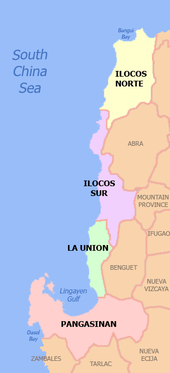Batac
| Batac | ||
|---|---|---|
| Component City | ||
| City of Batac | ||
|
Batac Government Building South Wing | ||
| ||
| Nickname(s): Home of Great Leaders; City of my Dreams | ||
 Map of Ilocos Norte showing the location of Batac | ||
.svg.png) Batac Location within the Philippines | ||
| Coordinates: 18°03′N 120°34′E / 18.050°N 120.567°ECoordinates: 18°03′N 120°34′E / 18.050°N 120.567°E | ||
| Country | Philippines | |
| Region | Ilocos (Region I) | |
| Province | Ilocos Norte | |
| District | 2nd District | |
| Founded | 1577 | |
| Cityhood | June 23, 2007 | |
| Barangays | 43 | |
| Government[1] | ||
| • Mayor | Albert D. Chua (NP) | |
| • Vice Mayor | Jeffrey Jubal C. Nalupta (NP) | |
| Area[2] | ||
| • Total | 161.06 km2 (62.19 sq mi) | |
| Population (2015)[3] | ||
| • Total | 55,201 | |
| • Density | 340/km2 (890/sq mi) | |
| Time zone | PHT (UTC+8) | |
| ZIP code | 2906 | |
| Dialing code | 77 | |
| Income class | 5th class | |
| Website |
batac | |
Batac is a city in the province of Ilocos Norte, Philippines. It is located in the northwest corner of Luzon island, about 11 kilometres (6.8 mi) from the eastern shores of the South China Sea. The municipalities of Banna, Currimao, Paoay, Pinili, Sarrat, Marcos and San Nicolas form its boundaries. According to the 2015 census, it has a population of 55,201.[3]
Batac is known as the "Home of Great Leaders", as it is the hometown of many significant figures in the history of the Philippines. Among them is the former Philippine president Ferdinand Marcos. It is also the birthplace of Gregorio Aglipay, the founder of the Philippine Independent Church, better known as the Aglipayan Church, and Gen. Artemio Ricarte, the "Father of the Philippine Army". Batac is well known for being the home of the Mariano Marcos State University (MMSU), a high-degree-granting university that has several branches throughout the province.
History
Batac was founded by the Augustinians in 1587 under the patronage of the Immaculate Conception. It is the second oldest town established by the Augustinians in the province of Ilocos Norte. Hence, in 1987, Batac reached its 4th centennial.
Batac was officially organized into a ministry on January 5, 1586. The first priest assigned to cathecize the natives of tile community was Esteban Marin, an Augustinian who probably arrived in Batac in 1585. Paoay and Dinglas (Dingras) were then the visitas of Batac.
Folk history states that there were two villages in Batac during the early part of tile foundation of the town, one was an Itneg community which occupied sitio Nangalisan and a Christian community occupying San José.
The first site of tile poblacion was in San José, which is now called Barangay Palpalicong. It is said that the ethnic minority groups of Bangui and Nueva Era are the pre-Spanish descendants of early inhabitants of Batac.
The Augustinians considered the people of Batac more civilized than tile other tribes, because they were better than the other "Indios" in personal cleanliness.
Origin of the city's name
The word Batac translates as "pull" in the Ilocano language. More loosely, it refers to "the people's pulling their efforts together."
Batac has an interesting colloquial origin of its name. According to a legend, set in pre-settlement Batac, a man fell into a deep hole while he was digging for the root crop "camangeg". He struggled to get out but could not despite his best efforts. He cried for help but nobody was around. He waited for hours and had given up hope of being saved. Fortunately, two men from the neighboring town of Paoay happened to pass by. They heard the man shouting and traced it to where he was trapped. Upon seeing him, they heard the man said "Batakennak! Batakennak!" The two men did not understand until the man explained that he was saying, "Pull me up! Pull me up!" They did just that. When the two men reached their hometown, they told their story to their friends. Since then, the town has been called "Batac," which is derived from the word "batakennak."
Cityhood
-
During the 11th Congress (1998–2001), Congress enacted into law 33 bills converting 33 municipalities into cities. However, Congress did not act on a further 24 bills converting 24 other municipalities into cities.
During the 12th Congress (2001–2004), Congress enacted into law Republic Act No. 9009 (RA 9009), which took effect on 30 June 2001. RA 9009 amended Section 450 of the Local Government Code by increasing the annual income requirement for conversion of a municipality into a city from ₱20 million to ₱100 million. The rationale for the amendment was to restrain, in the words of Senator Aquilino Pimentel, "the mad rush" of municipalities to convert into cities solely to secure a larger share in the Internal Revenue Allotment despite the fact that they are incapable of fiscal independence.
After RA 9009 went into effect, the House of Representatives of the 12th Congress adopted Joint Resolution No. 29, which sought to exempt from the ₱100 million income requirement in RA 9009 the 24 municipalities whose cityhood bills were not approved in the 11th Congress. However, the 12th Congress ended without the Senate having approved Joint Resolution No. 29.
During the 13th Congress (2004–2007), the House of Representatives re-adopted former Joint Resolution No. 29 as Joint Resolution No. 1 and forwarded it to the Senate for approval. However, the Senate again failed to approve the Joint Resolution. Following the suggestion of Senator Aquilino Pimentel (Senate President), 16 municipalities filed, through their respective sponsors, individual cityhood bills. The 16 cityhood bills each contained a common provision exempting it from the ₱100 million income requirement of RA 9009 –
"Exemption from Republic Act No. 9009. — The City of x x x shall be exempted from the income requirement prescribed under Republic Act No. 9009."
On 22 December 2006, the House of Representatives approved the cityhood bills. The Senate also approved the cityhood bills in February 2007, except that of Naga, Cebu which was passed on 7 June 2007. These cityhood bills lapsed into law on various dates from March to July 2007 after President Gloria Macapagal-Arroyo failed to sign them.
Republic Act 9407, the law that converted the Municipality of Batac into a component city in the Province of Ilocos Norte, to be known as Batac City, was overwhelmingly ratified by the people in a plebiscite conducted on June 23, 2007.The point of law at issue in 2007 was whether there had been a breach of Section 10, Article X of the 1987 Constitution, which provides –
No province, city, municipality, or barangay shall be created, divided, merged, abolished or its boundary substantially altered, except in accordance with the criteria established in the local government code and subject to approval by a majority of the votes cast in a plebiscite in the political units directly affected.
– and in each case the established criteria were far from met.
In November 2008, Batac and 15 other cities lost their cityhood after the Supreme Court of the Philippines granted a petition filed by the League of Cities of the Philippines, and declared unconstitutional the cityhood law (RA 9407) which had allowed the town to acquire its city status.[4] The Supreme Court ruled that they did not pass the requirements for cityhood.[5][6]
On 10 December 2008, the 16 cities affected acting together filed a motion for reconsideration with the Supreme Court. More than a year later, on 22 December 2009, acting on said appeal, the Court reversed its earlier ruling as it ruled that "at the end of the day, the passage of the amendatory law" (regarding the criteria for cityhood as set by Congress) "is no different from the enactment of a law, i.e., the cityhood laws specifically exempting a particular political subdivision from the criteria earlier mentioned. Congress, in enacting the exempting law/s, effectively decreased the already codified indicators."[7] Accordingly cityhood status was restored.
But on 27 August 2010, the 16 cities lost their city status again, after the Supreme Court voted 7-6, with two justices not taking part, to reinstate the 2008 decision declaring as "unconstitutional" the Republic Acts that converted the 16 municipalities into cities. A previous law required towns aspiring to become cities to earn at least ₱100 million annually, which none of the 16 did.[8]
On 15 February 2011, the Supreme Court made another volte-face and upheld for the third time the cityhood of 16 towns in the Philippines.[9]
Finally, on 12 April 2011, the Supreme Court, in an en banc ruling delivered in Baguio City, affirmed the finality of the constitutionality of the 16 cityhood laws by resolving that:
We should not ever lose sight of the fact that the 16 cities covered by the Cityhood Laws not only had conversion bills pending during the 11th Congress, but have also complied with the requirements of the LGC prescribed prior to its amendment by R.A. No. 9009.[8] Congress undeniably gave these cities all the considerations that justice and fair play demanded. Hence, this Court should do no less by stamping its imprimatur to the clear and unmistakable legislative intent and by duly recognizing the certain collective wisdom of Congress. WHEREFORE, the Ad Cautelam Motion for Reconsideration (of the Decision dated 15 February 2011) is denied with finality.[9]
On 28 June 2011 the Supreme Court directed the Clerk of Court to issue the entry of judgment on the cityhood case of 16 municipalities.[10] This entry of judgment ended the cityhood battle of the 16 cities.
Barangays
Batac is politically subdivided into 43 barangays, 14 of which constitute the poblacion.[2]
- Brgy.1-S Valdez (Caoayan) (Pob.)
- Brgy.1-N Ricarte (Nalasin) (Pob.)
- Brgy.2 Ablan (Labucao) (Pob.)
- Brgy.3, Cangrunaan (Pob.)
- Brgy.4, Nalupta (Suabit) (Pob.)
- Brgy.5, Callaguip (Pob.)
- Brgy.6, San Julian (Pob.)
- Brgy.7, Caunayan (Pob.)
- Brgy.8, Acosta (Iloilo) (Pob.)
- Brgy.9, Aglipay (Pob.)
- Brgy.10-S, Barani (Pob.)
- Brgy.10-N, Lacub (Pob.)
- Brgy.11 Ben-Agan (Pob.)
- Brgy.12, Palpalicong (Pob.)
- Brgy.13, Baay
- Brgy.14, Bungon
- Brgy.15, Baligat
- Brgy.16-S, Quiling Sur
- Brgy.16-N, Quiling Norte
- Brgy.17, Tabug
- Brgy.18, Magnuang
- Brgy.19, Pimentel (Cubol)
- Brgy.20-S, Mabaleng
- Brgy.20-N, Colo
- Brgy.21, Quiom
- Brgy.22, Maipalig
- Brgy.23, Bininggan
- Brgy.24, Sumader
- Brgy.25-N, Camguidan
- Brgy.25-S, Payao
- Brgy.26, Parangopong
- Brgy.27-E, Capacuan
- Brgy.27-W, Naguirangan
- Brgy.28, San Mateo
- Brgy.29, San Pedro
- Brgy.30-E, Baoa East
- Brgy.30-W, Baoa West
- Brgy.31, Camandingan
- Brgy.32, Palongpong
- Brgy.33-S, Rayuray
- Brgy.33-N, Nagbacalan
- Brgy.34, Dariwdiw
- Brgy.35, Bil-loca
Demographics
| Population census of Batac | ||
|---|---|---|
| Year | Pop. | ±% p.a. |
| 1990 | 43,092 | — |
| 1995 | 45,534 | +1.04% |
| 2000 | 47,682 | +0.99% |
| 2007 | 50,675 | +0.84% |
| 2010 | 53,542 | +2.02% |
| 2015 | 55,201 | +0.58% |
| Source: National Statistics Office[3][11] | ||
Economy
The Batac City Public Market touted as one of the biggest in the region offers a wide array of goods - freshly picked local vegetables and fruits, handicrafts, tincrafts, pottery, native delicacies, chicharon, longganisa, wet market treats and many others. The Delicia Center, located adjacent to the City Public Market, contains RTW shops, banks, appliance stores, farm supplies, pharmacies, groceries, a lottery outlet and many more. The Delicia Center and the City Public Market form part of the commercial district of Batac City.
With the presence of the Central Bank of the Philippines Cash Unit in the Batac City Government Center, financial institutions continue to spawn - Philippine National Bank, RCBC, Metrobank, Land Bank, BPI, Bank of Commerce, BDO and other local banks. Proof that Batac City is offering a good business climate to investors.
The Plaza Maestro Complex, one of the most modern shopping centers in the province caters to the needs of the new generation, offering two of the country's top fast food chains (Jollibee and Chowking), several boutique shops, a drugstore and a photo shop, among others. A stone's throw away from the commercial complex are bakeshops and a local pizza house.
Education
Batac National High School (BNHS) is the most popular high school in the city. It has three campuses: Poblacion, Bungon and Payao.
The Mariano Marcos State University (MMSU) is a comprehensive institution of higher learning in the Ilocos Region. MMSU's root anchored deep, its foundation is strong, and its beginnings all proven historical turning points as far back as the early 1900s.
The city has one Catholic School, The Immaculate Conception Academy. It was named after Immaculate Conception, the patron saint of the city. It is under the Missionary Sisters Servants of the Holy Spirit (SSpS). It was founded in 1963. It is located beside the Immaculate Conception Parish.
Tourism
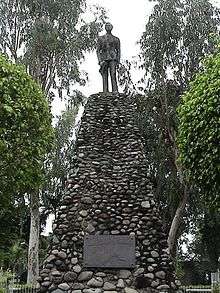
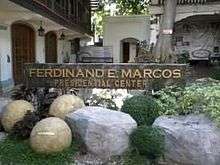
The Marcos Museum and Mausoleum lies in the heart of the city. The Mausoleum is where the glass-entombed, preserved corpse of Former President Ferdinand E. Marcos is found. The Museum holds the memorabilia of the late President, from his stint in the Armed Forces down to his presidency. Other notable sons of Batac include Gen. Artemio Ricarte, the Father of the Philippine Army and Msgr. Gregorio Aglipay, the founder of the Philippine Independent Church. Monuments and shrines of these heroes had been erected and named after them.
The Batac Riverside Empanadaan is a showcase of the most famous product of Batac and a hallmark of tourism promotion. A home of Batac's array of products, gift shops, food stalls offering mouth watering treats like empanada, miki, longganisa, pusit, barbecue and others. Declared by a feng shui practitioner as a very good location to do business in the area, now serves as a "mini pueblo" or a mini-mall where people converge, eat, dine, shop and while the time away.
When it comes to Empanada, Batac offers the best. With a distinct taste truly its own, it is made of a savory filling of grated green papaya, mongo, chopped Ilocano Sausage (longganisa) and egg. The dough that serves as its thin and crisp wrapper is made of rice flour. Batac Empanada is deep-fried rather than baked.
The city has two festivals, The Farmers Festival and The Empanada Festival. The Farmers’ Festival, conducted in the first week of May each year is a celebration of bountiful harvest and a tribute to the farmers of the city. It is participated by the rural barangays of the city. The Empanada Festival is a festivity held on the 23rd of June in celebration of the City's Charter Day. The main feature of the festival is the street dancing which chronicles the process of preparing the delectable Batac Empanada.
The Batac City Fiesta, a month-long festivity commencing on the 8th of December, is the longest fiesta in the Province of Ilocos Norte. The fiesta is celebrated in honor of the city's patroness, Our Lady of the Immaculate Conception. The fabulous Electric and Lights Parade marks the beginning of the City Fiesta every December 8.
Local government
Term of Office: June 30, 2016 – June 30, 2019
| Position | Name of City Official |
|---|---|
| City Mayor | Hon. Albert D. Chua |
| City Vice - Mayor | Hon. Jeffrey Jubal C. Nalupta |
| City Councilor | Hon. Gwyneth S. Quidang |
| City Councilor | Hon. Medeldorf M. Gaoat |
| City Councilor | Hon. Joel R. Garcia |
| City Councilor | Hon. Elmer D. Pungtilan |
| City Councilor | Hon. Jeremiah C. Nalupta |
| City Councilor | Hon. Avelard Ibarra F. Crisostomo |
| City Councilor | Hon. MacArthur A. Aguinaldo |
| City Councilor | Hon. Bernardo K. Marders |
| City Councilor | Hon. Jaime S. Tanagon, Sr. |
| City Councilor | Hon. Mary Coleen Columbia L. Cajigal |
| ABC President | Hon. Johann C. Nalupta |
| SK President | (Vacant) |
List of Mayors
- 1900: Hon. Sereno Franco
- 1904: Hon. Claudio Asuncion
- 1906: Hon. Sereno Franco
- 1910: Hon. Santiago Espiritu
- 1912: Hon. Galo Luzod
- 1916: Hon. Higidio Layaoen
- 1917: Hon. Mauricio Sabas
- 1919: Hon. Higidio Layaoen
- 1922: Hon. Isidro Morales
- 1925: Hon. Eugenio Mendoza
- 1928: Hon. Urbano Arcangel
- 1931: Hon. Eugenio Mendoza, Sr.
- 1934: Hon. Leon Verano
- 1941: Hon. Catalino Acosta
- 1942: Hon. Sereno Franco (Japanese Occupation)
- 1942: Hon. Catalino Acosta (Liberation)
- 1945: Hon. Vicente Castro (Military Government)
- 1946-1952: Hon. Mariano Nalupta, Sr.
- 1956-1977: Hon. Feliciano Q. Asuncion
- 1977-1987: Hon. Fe P. Acosta - Aguinaldo
- 1986-1987: Hon. Bonifacio G. Agdigos (OIC)
- 1987-1988: Hon. Pastor N. Nalupta
- 1988–1998: Hon. Jesus R. Nalupta, Sr,
- 1998-2001: Hon. Elena M. Nalupta
- 2001-2007: Hon. Jesus R. Nalupta, Sr.
- 2007–2016: Hon. Jeffrey Jubal C. Nalupta
- 2016-Present: Hon. Albert D. Chua
Notable people from Batac City
-

Ferdinand Marcos - The 10th President of the Philippines from 1965 to 1986.
-
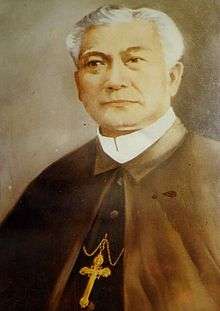
Gregorio Aglipay - The first Filipino Supreme Bishop of the Philippine Independent Church.
-

Artemio Ricarte - A Filipino general during the Philippine Revolution and the Philippine–American War. Considered the "Father of the Philippine Army".
-
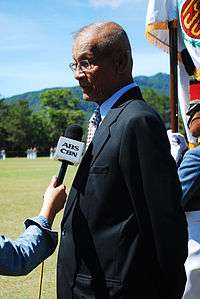
Rodolfo Biazon - Senator of the Philippines from June 30, 1992 up to June 30, 1995, and from June 30, 1998 up to June 30, 2010.
Sister cities
-
 Makati City, Philippines
Makati City, Philippines -
 Carcar City, Philippines
Carcar City, Philippines -
 Naga City, Cebu, Philippines
Naga City, Cebu, Philippines -
 Cabadbaran City, Philippines
Cabadbaran City, Philippines -
 Tabuk City, Philippines
Tabuk City, Philippines -
 Lamitan City, Philippines
Lamitan City, Philippines
References
- ↑ "Official City/Municipal 2013 Election Results". Intramuros, Manila, Philippines: Commission on Elections (COMELEC). 11 September 2013. Retrieved 30 September 2013.
- 1 2 "Province: ILOCOS NORTE". PSGC Interactive. Makati City, Philippines: National Statistical Coordination Board. Archived from the original on 27 September 2013. Retrieved 30 September 2013.
- 1 2 3 "Total Population by Province, City, Municipality and Barangay: as of May 1, 2010". 2010 Census of Population and Housing. National Statistics Office. Retrieved 30 September 2013.
- ↑ Republic Act No. 9407 of 24 March 2007 Charter of the City of Batac
- ↑ G.R. No. 176951 et al. (First appeal) of 18 November 2008 Consolidated petitions for prohibition assailing the constitutionality of the subject Cityhood Laws and enjoining the Commission on Elections (COMELEC) and respondent municipalities from conducting plebiscites pursuant to the Cityhood Laws.
- ↑ Napallacan, Jhunex (2008-11-21). "Cities' demotion worries DepEd execs". Cebu Daily News. Inquirer.net. Retrieved 15 February 2015.
- ↑ G.R. No. 176951 et al. (First reversal) of 21 December 2009
- 1 2 Republic Act No. 9009 of 24 February 2001 An Act amending section 450 of Republic Act no. 7160, otherwise known as the Local Government Code of 1991, by increasing the average annual income requirement for a municipality or cluster of barangays to be converted into a component city.
- 1 2 G.R. No. 176951 et al. (Second appeal) of 15 February 2011 League of Cities of the Philippines v. COMELEC
- ↑ G.R. No. 176951 et al. (Final Resolution) of 28 June 2011 Supreme Court has directed the Clerk of Court to forthwith issue the Entry of Judgment
- ↑ "Province of Ilocos Norte". Highlights of the Philippine Population 2015 Census of Population. Philippine Statistics Authority. Retrieved 28 May 2016.
External links
| Wikimedia Commons has media related to Batac, Ilocos Norte. |
- Official Website of Batac
- Philippine Standard Geographic Code
- Philippine Census Information
- Local Governance Performance Management System
 |
San Nicolas | Sarrat |  | |
| Paoay | |
Banna | ||
| ||||
| | ||||
| Currimao | Pinili | Nueva Era |


